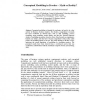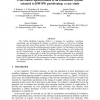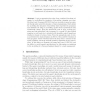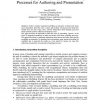CAISE
2003
Springer
14 years 4 months ago
2003
Springer
Conceptual modelling is thought (by academics at least) to be a key activity of Business Systems Analysis. For decades, comprehensive research has been conducted on related topics ...
FDL
2003
IEEE
14 years 4 months ago
2003
IEEE
The Unified Modelling Language (UML) is a language for specifying, visualizing, constructing, and documenting the artefacts of software systems, as well as for modelling business ...
AGP
2003
IEEE
14 years 4 months ago
2003
IEEE
Abstract. Logic programming has often been considered less than adequate for modelling the dynamics of knowledge changing over time. Evolving Logic Programs (EVOLP) has been recent...
PRICAI
2004
Springer
14 years 4 months ago
2004
Springer
In this paper, we extend our earlier work on modelling the mental states of PRS-like agents by considering the dynamics of belief and modelling of action attempts. The major constr...
OTM
2005
Springer
14 years 5 months ago
2005
Springer
Model-driven Architecture (MDA) is a software architecture framework proposed by the Object Management Group OMG. MDA emphasises the importance of modelling in the architectural de...
AIED
2005
Springer
14 years 5 months ago
2005
Springer
Today's computer supported modelling environments could provide much more information about the users’ actions and problem solving processes than they usually store for late...
ACL2
2006
ACM
14 years 5 months ago
2006
ACM
We have written a new records library for modelling fixedsize arrays and linear memories. Our implementation provides fixnum-optimized O(log2 n) reads and writes from ad
ER
2007
Springer
14 years 5 months ago
2007
Springer
Business modelling research is increasingly interested in exploring how domain ontologies can be used as reference models for business models. The Resource Event Agent (REA) ontolo...
ECSA
2007
Springer
14 years 5 months ago
2007
Springer
Abstract. The conceptual modelling of software architectures is of central importance for the quality of a software system. A rich modelling language is required to integrate the d...
SIES
2007
IEEE
14 years 5 months ago
2007
IEEE
The properties of a domain oriented modelling approach or language are determined by the dominant semantics of the domain. A significant subclass that needs particular attention,...




